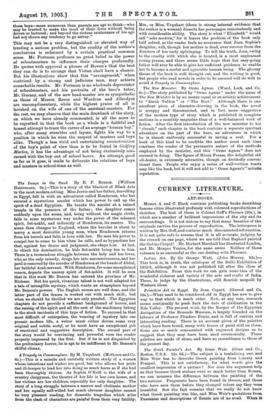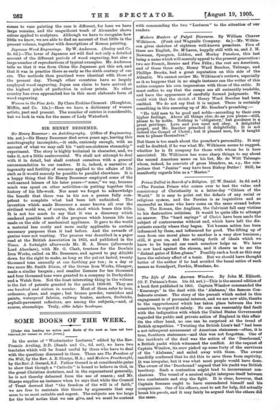Messrs. A. and C. Black continue publishing books describing famous
cities illustrated profusely with coloured reproductions of sketches. The best of these is Colonel Goff's Florence (20s.), in which are a number of brilliant impressions of the city and its surroundings. It is not untrue to say that many beauties of the originals survive the process of reproduction. The letterpress is written by Mrs. Goff, and contains much disconnected information. It is not quite safe to assume that it is all accurate, juiging by the remark on one page, where we are told that Raphael painted the Sistine Chapel! Mr. Herbert Marshall has illustrated London, and Mr. Menpes Venice, for the same series. Neither of these volumes is as successful as the one dealing with Florence.
Indian Art. By Sir George Watt. (John Murray. 12s.)— This book is, in truth, the catalogue of the Delhi Exhibition of 1902-3, although it was not published till after, the close of the Exhibition. From this work we can gain some idea of the wonderful richness and variety of the arts and crafts of India. These, to judge by the illustrations, still flourish unspoilt by Western ideas.
Primitive Art in Egypt. By Jean Capart. (Grevel and Co. 16s.)—What used to be considered old in Egypt has now to give way to that which is much older. Now, at any rate, research seems continually to push back the date of civilisation in the Nile Valley. The present work, by the Keeper of the Egyptian Antiquities of the Brussels Museum, is largely founded on the labours of Professor Flinders Petrie, and is full of curious and interesting reading. There is an account given of the palettes which have been found, many with traces of paint still on them. Some are so much ornamented with engraved designs as to suggest that they may have been used ceremonially. These palettes are made of stone, and have no resemblance to those of the present day.
The Greek Painter's Art. By Irene Weir. (Ginn and Co., Boston, U.S.A. 12s. 6d.)—The subject is a tantalising one, and Miss Weir has to describe Greek painting from hearsay and Pompeii. This is not satisfactory, for what words give the smallest impression of a picture ? Nor does the argument help us that because Greek statues were so much better than Roman, we can measure the difference between the painting of the two nations. Fragments have been found in Greece, and those who have seen them before they changed colour say they were beautiful. But the fact remains that we really do not know What Greek painting was like, and Miss Weir's quotations from Pausanias and descriptions of Zeuxis are of no avail. When it
comes to vase painting the case is different, for here we have large remains, and the magnificent tomb of Alexander shows colour applied to sculpture. Although we have to recognise how little we know, we are able to find an account of that little in the present volume, together with descriptions of Roman painting.
Japanese Wood Engravings. By W. Anderson. (Seeley and Co. 38. 6d.)—The lover of Japanese art will find not only a detailed account of the different periods of wood engraving, but also a large number of reproductions of typical examples. Mr. Anderson tells us that it was from China the Japanese got this art, and that it was in practice there as early as the sixth century of our era. The methods then practised were identical with those of the present day. Though other countries have so largely employed wood engraving, Japan can claim to have arrived at the highest pitch of perfection in colour prints. No other country has even approached her in this most elaborate form of wood engraving.
Women in the Pine Arts. By Clara Erskine Clement. (Houghton, Mifflin, and Co. 12s.)—Here we have a dictionary of women artists, past and present. The number of entries is considerable, but we look in vain for the name of Lady Waterford.



































 Previous page
Previous page